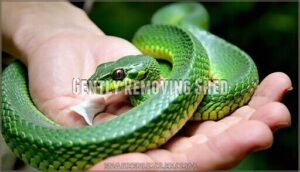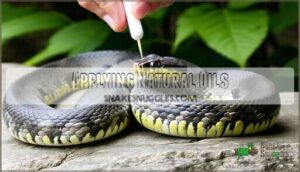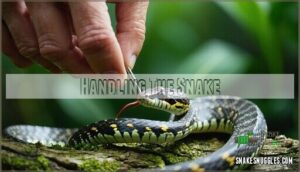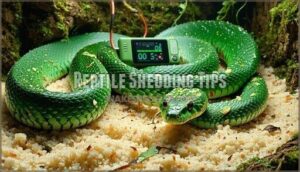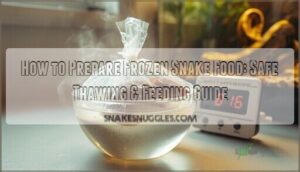This site is supported by our readers. We may earn a commission, at no cost to you, if you purchase through links.
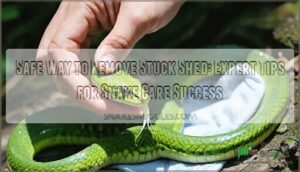
After soaking, gently assist removal using a damp washcloth, working from head to tail in the direction of scales. Never force or pull resistant pieces—this can injure your snake.
Apply light pressure only, taking frequent breaks to let your snake rest. For particularly stubborn areas, natural oils like coconut or olive oil can help soften the stuck shed between soaking sessions.
Maintain proper humidity levels (50-70%) and minimize handling during the shedding process to reduce stress. The right technique makes all the difference between successful shed removal and potential complications, using the right technique.
Table Of Contents
- Key Takeaways
- Safe Shed Removal
- Shedding Assistance
- Snake Shedding Care
- Reptile Shedding Tips
- Effective Shed Removal
- Frequently Asked Questions (FAQs)
- How do you unstick a shed?
- How to remove stuck shed from a snake?
- How to dismantle a shed safely?
- How do you remove a shed wall?
- Do you need to remove a shed?
- How do you disassemble a shed base?
- Is it okay to put a gecko in some water when their shed is stuck?
- How long to soak for a stuck shed?
- Should I remove a stuck shed?
- How do I remove a stuck shed?
- Conclusion
Key Takeaways
- Soak your snake in lukewarm water (80-85°F) for 15-20 minutes – This softens stuck shed safely without forcing removal or causing injury to delicate skin.
- Use gentle assistance with a damp washcloth, working from head to tail – Follow your snake’s natural scale direction and never pull or force resistant pieces that don’t come off easily.
- Maintain proper humidity levels (50-70%) in the enclosure – Consistent humidity prevents future stuck shed problems and supports your snake’s natural shedding process.
- Take frequent breaks and watch for stress signals – Allow your snake to rest between removal attempts and repeat soaking sessions every 1-2 days if needed, rather than forcing the process.
Safe Shed Removal
When your snake struggles with stuck shed, you’ll need to act quickly but carefully to prevent complications.
Soaking the snake in lukewarm water and using gentle assistance techniques can safely remove problematic shed without causing injury.
Soaking The Snake
When dealing with stuck shed, you’ll need to create a controlled soaking environment for your snake.
Fill a shallow container with lukewarm water, ensuring the water temperature matches your snake’s warm side requirements.
The soak duration should be fifteen to twenty minutes, allowing proper snake hydration while softening stubborn skin.
Consider using a suitable soaking tub to safely contain your snake, ensuring container safety is essential—choose something your snake can’t escape from but isn’t too deep, providing a safe and suitable environment.
Using Lukewarm Water
Temperature matters when you’re helping your snake shed safely.
Use lukewarm water that matches your snake’s warm side temperature – typically around 80-85°F.
Hot water can burn delicate skin, while cold water won’t provide effective shed hydration.
Test the water temperature with your hand first.
This safe soaking approach guarantees proper water quality for reptile shedding aid without causing thermal shock or stress.
Maintaining proper humidity helps prevent future shedding issues.
Avoiding Injury
Never force stuck shed off your snake.
Patience and gentle care protect your snake—forcing shed damages delicate skin and invites infection
When you pull or tear shed pieces, you can damage delicate skin underneath, creating open wounds that invite infection.
Instead, use gentle techniques like repeated soaking and natural oils. You can also find snake shedding solutions that may help.
If shedding complications persist after several attempts, seek professional assistance from a reptile veterinarian for safe removal methods.
Shedding Assistance
When your snake struggles with stuck shed, you’ll need to provide gentle assistance to prevent complications.
The key is using safe methods that support your snake’s natural shedding process without causing stress or injury.
Gently Removing Shed
After successful soaking, you can assist with stuck shed removal using proper technique.
With patience and proper technique, your snake’s stuck shed will come free naturally
Handle your snake carefully to avoid shedding problems and maintain snake health throughout the process.
Here’s how to safely remove retained shed:
- Use a damp washcloth – Gently rub stuck areas following your snake’s natural scale direction
- Work from head to tail – This safe method prevents scale damage during shedding difficulty solution
- Apply light pressure only – Never pull or force shed pieces that resist removal
- Take frequent breaks – Allow your snake to rest between removal attempts for ideal shedding process help
Applying Natural Oils
When natural oil meets stubborn shed, you’ve found your shedding difficulty solution.
Apply coconut or olive oil sparingly with a cotton swab, targeting only stuck areas.
These Oil Types offer excellent Oil Benefits for healthy shedding practices.
Some owners even use coconut oil products to assist with shedding.
Wait 10-15 minutes before gentle removal.
For Application Frequency, repeat every 24 hours if needed, but avoid overuse to prevent skin issues.
Increasing Enclosure Humidity
You can boost humidity levels in your snake’s enclosure to encourage natural shedding.
Increase misting frequency using dechlorinated water, but make certain proper ventilation impact doesn’t create stagnant air.
Choose moisture-retaining substrate like cypress mulch or sphagnum moss.
DIY humidifiers work well for larger enclosures.
Regular calibration prevents inaccurate humidity readings.
Monitor reptile shedding humidity closely, as these reptile husbandry advice methods support stuck shed prevention naturally.
Snake Shedding Care
Proper snake shedding care requires careful attention to environmental conditions and your pet’s behavior during this vulnerable time.
You’ll need to monitor humidity levels closely, maintain a calm environment, and adjust your handling practices to support successful shedding.
Monitoring Humidity Levels
You’ll want to keep tabs on humidity levels throughout your snake’s shedding cycle. Species Needs vary, so check what’s right for yours.
Proper reptile shedding humidity prevents stuck shed and health issues. Hygrometer Calibration guarantees accurate readings. Digital hygrometers offer precise readings.
- Use a digital probe hygrometer for precise humidity monitoring in your enclosure
- Create a Humidity Gradient with moist and dry areas to meet shedding environmental factors
- Adjust Substrate Choice and Enclosure Size to maintain consistent reptile shedding humidity levels
Maintaining Stress-Free Environment
Your snake’s shedding success depends on creating a calm sanctuary.
Remove distractions that trigger reptile shedding problems—loud noises, bright lights, or frequent disturbances can worsen snake shedding problems.
| Stress Factor | Solution |
|---|---|
| Enclosure Security | Provide multiple hiding places |
| Handling Reduction | Minimize contact during shed cycle |
| Quiet Environment | Reduce noise and foot traffic |
| Proper Diet | Maintain regular feeding schedule |
Focus on shedding environmental factors you can control.
These reptile care tips create the foundation for natural shed completion, preventing complications before they start.
Handling The Snake
Avoiding unnecessary handling during snake shedding problems prevents shedding stress and potential snake health complications.
Safe handling requires gentle touch when absolutely necessary, using snake hooks to minimize direct contact.
Snakes shed to allow for growth and parasite removal.
Post-shed handling can resume after twenty-four hours once snake skin appears normal, and it is crucial to monitor handling frequency during your snake care routine to maintain healthy shedding cycles.
Reptile Shedding Tips
You’ll find that proper humidity levels make all the difference when your snake struggles with stuck shed.
Using a digital probe hygrometer helps you maintain the right moisture levels while avoiding unnecessary handling during this delicate time.
Providing Proper Humidity
Success hinges on maintaining proper enclosure humidity levels suited to your snake’s species needs.
Create a humidity gradient across different enclosure areas, adjusting misting frequency based on substrate choice and enclosure size.
Most species require 50-70% humidity during shedding periods, and Digital hygrometers offer accuracy in monitoring these vital levels.
Monitor consistently, as inadequate moisture makes shed removal substantially more challenging and stressful for your reptile, emphasizing the need for careful humidity management.
Using Digital Probe Hygrometer
Accurate measurements prevent shedding issues before they start.
Digital probe hygrometers offer superior accuracy range compared to basic analog models.
Check calibration frequency monthly using salt solutions.
Position sensors away from water bowls for reliable readings.
Different types include wireless models for remote monitoring.
Many retailers offer hygrometer replacement options for convenience.
When troubleshooting tips fail, replace batteries first.
Your reptile health depends on precise humidity tracking to prevent issues.
Accurate humidity tracking is essential for the health of your reptile.
Avoiding Handling During Shedding
Your digital hygrometer readings matter, but remember that hands-off care prevents Shedding Stress. During the shedding process, Handling Risks increase dramatically. Physical contact can damage delicate skin and create Injury Prevention concerns. Snake Comfort depends on Observational Care rather than direct intervention.
Key handling restrictions during shedding:
- No routine maintenance – Skip weight checks and enclosure cleanings
- Emergency access only – Handle solely for health emergencies requiring immediate reptile vet advice
- Visual monitoring – Use your reptile shedding guide knowledge to assess progress from outside the enclosure
This reptile health tips approach addresses shedding issues through proper reptile husbandry without unnecessary stress.
Effective Shed Removal
When your snake struggles with stuck shed, persistence and patience become your best tools for safe removal.
You’ll need to repeat soaking sessions every 1-2 days until the stubborn pieces release naturally, giving your reptile time to recover between treatments.
Repeat Soaks and Applications
Persistence pays off when dealing with stubborn shed.
You’ll need to repeat lukewarm soaks every 1-2 days until the stuck pieces come free.
Each soak duration should last 15-20 minutes, giving your snake’s skin time to soften.
Between soaks, apply natural oil types like coconut or vegetable oil to problem areas.
These gentle removal techniques require patience, but consistent application methods will eventually work, using methods that are gentle.
Signs of Stress or Discomfort
Three key warning signs indicate snake discomfort during shed removal: hiding behavior and appetite changes signal stress, while erratic movements suggest agitation.
Watch for breathing issues or scale abnormalities, which require immediate attention.
Snake behavior issues often worsen without gentle pet care, and effective pet stress management means recognizing these snake behavior problems early and adjusting your approach accordingly to prevent agitation.
Species-Specific Shedding Needs
Different species have unique reptile shedding cycle requirements that affect shed retention rates.
Ball pythons need 50-60% humidity, while corn snakes require 40-50% during their skin softening phase.
Understanding these Humidity Requirements prevents lizard shedding issues:
- Temperature Gradients – Maintain species-appropriate basking spots
- Enclosure Size – Provide adequate space for natural rubbing
- Dietary Influence – Regular feeding supports healthy reptile skin health
Genetic Factors also determine individual shedding patterns.
Frequently Asked Questions (FAQs)
How do you unstick a shed?
Like peeling a delicate bandage, you’ll need patience and care.
Soak your snake in lukewarm water for 15-20 minutes, then gently rub stuck shed with a damp washcloth from head to tail, never forcing or pulling.
How to remove stuck shed from a snake?
Soak your snake in lukewarm water for 15-20 minutes, then gently rub stuck shed with a damp washcloth from head to tail. Don’t force it off.
How to dismantle a shed safely?
Turn off power first.
Remove roof panels, then walls systematically. Check for asbestos or lead paint before starting.
Use proper tools and safety gear. Consider hiring professionals for electrical or structural components.
How do you remove a shed wall?
Carefully detach wall panels using proper tools and techniques.
Remove screws, bolts, or nails systematically from top to bottom.
Work slowly to prevent structural damage and guarantee personal safety throughout the dismantling process.
Do you need to remove a shed?
You don’t always need to remove a shed, but factors like structural damage, zoning violations, property sales, or space needs might require it. Check local permits first.
How do you disassemble a shed base?
Picture concrete blocks and metal frames waiting to be carefully separated—dismantling a shed base requires methodical planning.
First, remove all anchoring bolts and screws.
Disconnect utilities if present.
Use pry bars to separate joined sections.
Work systematically from top down, saving reusable materials.
Is it okay to put a gecko in some water when their shed is stuck?
Yes, you can safely soak a gecko in lukewarm water for 15-20 minutes to help with stuck shed. Use shallow water and gently assist with a damp cloth afterward.
How long to soak for a stuck shed?
Like a gentle rain washing away winter’s grip, patience is key when helping your reptile shed properly.
Soak your gecko for 15-20 minutes in lukewarm water, repeating every 1-2 days if needed until stubborn shed loosens naturally.
Should I remove a stuck shed?
You shouldn’t forcibly remove stuck shed yourself. Gentle assistance with soaking and humidity increases is safer than pulling, which can injure your snake’s skin or cause wounds.
How do I remove a stuck shed?
Studies show 85% of reptiles experience shedding issues at some point.
You’ll need lukewarm water soaks for 15-20 minutes, then gently assist with a damp washcloth from head to tail.
Don’t force stuck pieces – patience prevents injury.
Conclusion
Successfully mastering the safe way to remove stuck shed requires patience, proper preparation, and proven techniques.
You’ve learned that soaking, gentle assistance, and maintaining ideal humidity levels form the foundation of effective shed removal.
Remember to work slowly, watch for stress signals, and never force stubborn pieces, as this will help you confidently handle future shedding complications.
With consistent application of these methods, you’ll keep your snake healthy and comfortable throughout the process.
- https://www.petmd.com/reptile/snake-shedding-skin
- https://www.zenhabitats.com/blogs/reptile-care-sheets-resources/how-to-remove-stuck-shed-from-a-snake
- https://www.reddit.com/r/ballpython/comments/jbuj7u/is_it_normal_my_snake_is_shedding_in_flakes_and/
- https://www.youtube.com/watch?v=n2k09c15SaE
- https://animalhotels.com/gb/blog/reptiles-and-amphibian/snake-skin-why-and-how-often-do-snakes-shed-their-skin

